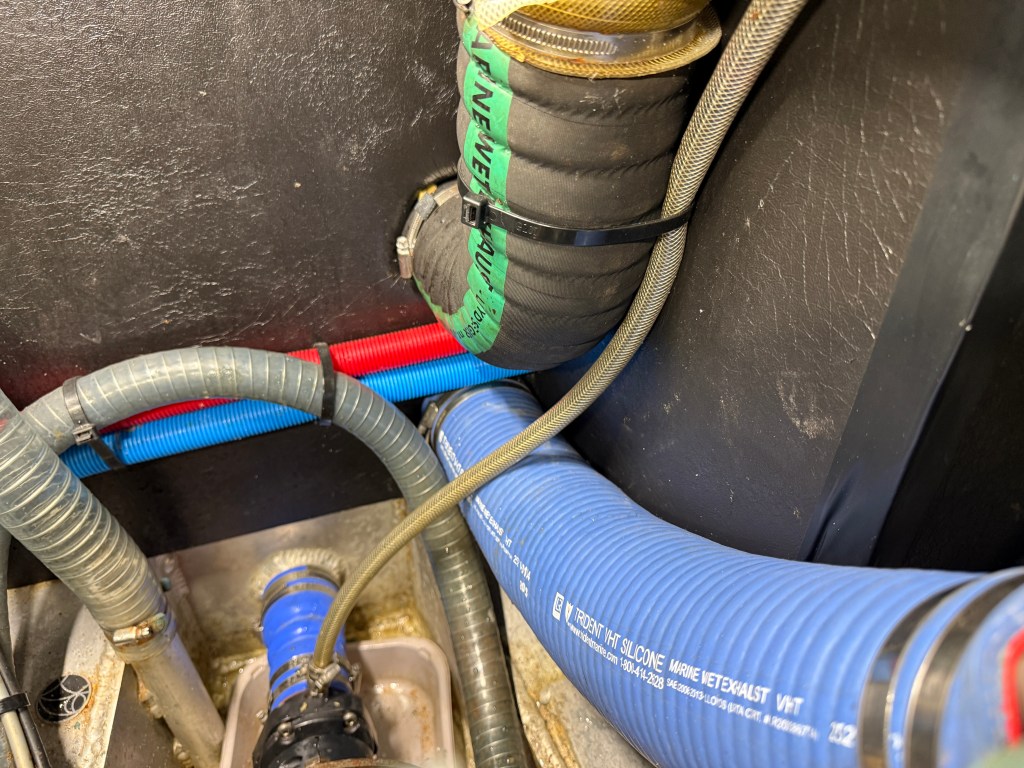Our unplanned pit-stop in Newport Oregon brought us some great surprises. A visit to the Newport Aquarium (awesome!), a killer meal at the Rogue Brewery (but don’t order the oyster shooters), and new friendships on either side of the dock, including two vessels who found themselves in similar situations and had been towed in by the USCG the day before Flyer. Both boats were in very experienced hands, helping me feel a bit better about myself… these things do happen to the best of us.

(Warning: boring technical marine diesel engine content follows)
I proceeded to do three more oil changes while at the dock, the oil improving drastically in appearance each time. I ran the engine for only 10-15 seconds between each change just to flush the oil through the system, but not enough to tax the engine if there was still a saltwater leak or another major issue. The 4th oil change showed normal oil color at a consistent level. We ran the engine for 30 minutes and, after waiting a while at rest, concluded there was no leak inside the engine given the oil level and quality remained the same.
If there was no seawater entering the engine at the dock, the only other places to look are in the exhaust system or the seawater cooling system, both of which can experience different pressures and external forces when sailing. Over the winter we had done a full scoping inspection of the exhaust system, as well as a full service and disassembly of the heat exchanger and found no anomalies or points of failure in this system. And with some visual surveying of the engine exhaust system by our new friend Kevin at the dock in Newport, we concluded there was no way the sea water could have entered through the exhaust hoses. The exhaust loop – which rises well above the static waterline of the boat, close to the boat’s centerline – is designed to keep this from happening.*
As I was pointing out the system elements to Kevin it occurred to us that the propeller shaft-seal system seemed to be plumbed in a somewhat questionable way. It’s designed to use pressurized seawater -from the engine cooling system- to keep the shaft seal lubricated and cool while spinning. This line – a 3/8” clear tube- seemed to be low in elevation, and it was plumbed directly from the last leg of our seawater line before it connects to the exhaust injection elbow. The boat had been loaded significantly more than ever before – she was probably 3” lower on her lines than we have had her in the past. This, coupled with our long day heeled over to port -the side that this system is plumbed to- likely served to raise the static waterline, and aid in developiong siphon of seawater direct into the exhaust injection elbow.


I removed the hose and tested this theory at the dock. I found that I could easily pull a siphon with hardly an effort. This could have produced 2 gallons or more an hour of seawater into the exhaust system, filling up the exit hose, water-lift box, and backfilling into the engine itself through the exhaust manifold.
Without the proper repair items at hand, and with limited marine stores locally, we decided to head south for San Francisco and make the final repair there. In the meantime we’d need the engine to get us the first hundred miles or so through a light patch with little wind, and when the breeze was forecast to build, we’d either keep the engine going at idle (to maintain positive pressure on the system) or turn it off and monitor it regularly.
Our strategy for our departure was to get moving while the weather looked good for some downwind sailing and that either way -if we had solved the problem, or not- we would be moving the boat towards the Bay Area, where resources and expertise abound in comparison to Newport.
This ordeal had cost us several gallons of engine oil (heaps of thanks to both Cameron and his dad who both purchased and drove us to acquire more engine oil during our troubleshooting time). Moreover we had used 4 of our 7 replacement engine oil filters, and our engine (a Volvo Penta) of course requires a non-standard filter, not available anywhere in Newport or within 100 miles!
Out of pure chance, our good friends from Portland happened to be driving to Newport for their annual beach-camping trip, and were able to swing by the Volvo Penta dealer in Northeast Portland to pick up more filters to bring to us. It was a relief to know we would have more oil changes available to us in the coming weeks and a total delight to see them again, this time on the dock in Newport.
After just over 48 hours in Newport and several cases of DELO 15w-40 oil now circulated through the engine, we pushed off on August 30 for San Francisco.





_____________________
Note:
*There has been some uncertainty in the Boreal community recently of a larger design flaw in the stock engine exhaust system after the flooding of Charlie Doane’s** engine on the Boreal 47 Lunacy (close to an older sister-ship of Flyer). Charlie expertly and humorously documented his issues on his blog here, and I had been very familiar with his experience as well as those of a couple other owners since purchasing Flyer. Doane’s engine flooding occurred after several days of hard, downwind sailing, and he and a few other experts close to the case felt it was because of the Boreal’s side-exhaust design.
I’d been concerned of this as well on Flyer, though in this case, given the speed of our incident (after less than 12 hours sailing), the fact that we remained only on starboard gybe the whole time (not ‘swallowing’ the water by gybing, as Lunacy had), the fact that the exhaust system had recently been inspected by trusted experts, as well as the ease with which our shaft-seal water line siphoned while sitting at the dock, points to the shaft-seal line as the culprit in this case.
** Charlie is also a writer and author of several great reads, his most recent is The Boy Who Fell to Shore. Well worth a read by anyone who enjoys non-fiction about sailing, eccentrics, and mysterious disappearances!

Leave a Reply to Mara BarckertCancel reply